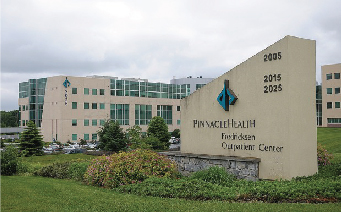Healthcare providers are good at managing patients’ medical conditions while they are in the hospital or office, but for patients with chronic health conditions, that is only one piece of the puzzle. What happens while the patient is at home? Is their condition improving or worsening? What factors affect the likelihood of them needing to be readmitted? The question is: how can healthcare organizations change the way they deliver care to improve patient outcomes over the long term – especially when they have limited resources at their disposal?
For PinnacleHealth, the key is to look beyond how a patient is managed in the hospital and examine the bigger picture. Today, the organization uses IBM analytics solutions to assemble, explore and discover data from patient records, and combine it with information gathered during a hospital stay. It then uses this holistic view of the patient’s life to predict the risk of readmission.
By alerting physicians and caregivers to high-risk patients, PinnacleHealth can focus intervention on the patients who really need help, and intervene in a timely manner. Working with Waypoint Consulting, PinnacleHealth is taking the first steps towards a revolutionary new approach to healthcare delivery.
Striving to do better
PinnacleHealth’s mission is to improve the health and quality of life for the people of central Pennsylvania, and it has consistently ranked highly in quality and patient experience across a wide range of medical conditions and procedures. To retain its reputation for excellence, the organization cannot afford to stop innovating. When it saw a chance to improve the long-term outlook for patients with chronic health conditions, it seized the opportunity.
Dr. George Beauregard, senior vice president and chief clinical officer at PinnacleHealth System, elaborates: “Hospital readmissions for patients with chronic health conditions are a hot-button issue in the United States right now, with the government recently imposing financial penalties for organizations with higher than acceptable rates. Although our readmission rate was already lower than the national average, we saw an opportunity to do even better – to improve population health and reduce costs.” There are a number of intervention activities that have proven to be effective in helping those with chronic conditions maintain a good health status for longer with limited resources; the challenge is working out where they will be most effective.
There are a number of intervention activities that have proven to be effective in helping those with chronic conditions maintain a good health status for longer with limited resources; the challenge is working out where they will be most effective.
“When a patient is admitted to a hospital, it is very easy to concentrate on solving the immediate problem and then send them home,” comments Dr. Beauregard. “The unfortunate reality is that there are so many factors in that environment that can lead to that person’s health declining again. Adherence with follow-up care, their level of engagement, attitude and confidence in managing their condition, whether they understand their diagnosis, and prognosis and medications are just some of the things that can make a significant impact. Our challenge was: how could we make it easy for physicians and caregivers – whose time and resources are limited – to look at the bigger picture?”

Embracing predictive analytics
For PinnacleHealth, the answer to this question was clear: if it could predict which patients were most at risk of readmission, it could use this insight to focus attention on the people who need it most and plan intervention activities that would really make a difference. The organization engaged IBM Premier Business Partner and analytics specialist Waypoint Consulting to make these goals a reality.
“It was a natural decision for us to extend our existing IBM Cognos Business Intelligence solution with a predictive component based on IBM SPSS Modeler,” says Dr. Beauregard. “Waypoint Consulting brought the data science knowledge and healthcare expertise needed to make the project a success.”
PinnacleHealth initiated a pilot study, taking three years’ worth of data on 225 patients with chronic obstructive pulmonary disease (COPD) and creating a model to predict their admissions using a range of clinical factors.
“The pilot study was a success: our SPSS model predicts readmissions for COPD patients with 85 percent accuracy – a rate that will improve as we refine the model,” explains Dr. Beauregard. “We used this pilot to build a business case showing the potential financial savings and improvements in patient outcomes if we target the patients who are most likely to be readmitted. With the cost per readmission for a patient with COPD around USD6,200 and the possibility of extending similar analytical techniques to a variety of other chronic conditions, our CEO immediately saw the potential. We assembled a multidisciplinary team and started the work.”
Solution in action 
The solution automatically delivers a report to physicians at the point of care when a patient with COPD is admitted to one of PinnacleHealth’s hospitals. This report predicts the likelihood of readmission within a range of time periods and the probable time until an exacerbation of the patient’s condition is likely to occur, alongside details such as comorbidities and other medications. The report is built on data from the organization’s core clinical and financial systems, as well as vital signs and lab results recorded during the patient’s hospital stay.
Dr. Beauregard says: “The insights we glean from the IBM solution help encourage our physicians and care coordinators to step back and look at the entire health continuum for those patients who are most at risk of readmission. As a result, we can initiate a set of interventions where they are most needed.
“For example, we can check whether a patient can easily access their medication and understands how to take it; we can ensure that they are adequately engaged in self-care; we can arrange a home visit by our community paramedicine team, or a follow-up appointment with a pulmonologist; we can even offer counseling to help patients quit smoking while they are still in the hospital.”
Just the beginning
By revealing aspects of the patient that were invisible before, the solution helps PinnacleHealth make decisions that offer patients the maximum benefit over the long term, reducing the rate of readmissions. Dr. Beauregard adds: “As soon as the intervention activities are hardwired into our care delivery process, we expect to realize the benefits for patient health and cost efficiency provided by the IBM solution.”
Dr. Beauregard concludes: “Reducing the number of readmissions for patients with COPD is just the beginning. We already plan to build predictive models to help retard the progression of chronic kidney disease, cardiovascular disease and others. We’re early in this process and many lessons have already emerged. With IBM solutions and Waypoint Consulting, we are revolutionizing our approach to healthcare delivery across the board.”
About PinnacleHealth
PinnacleHealth is the leading hospital and healthcare system in central Pennsylvania. A non-profit organization, PinnacleHealth delivers more than 5,000 babies and performs more than 23,000 surgical procedures, 588 open heart surgeries and 70 kidney transplants each year.
To learn more about PinnacleHealth, please visit http://www.pinnaclehealth.org/
 About Waypoint Consulting
About Waypoint Consulting
Waypoint Consulting is one of the leading providers of business intelligence and financial performance management solutions in the mid-Atlantic region of the United States. Based outside of Philadelphia, the company specializes in taking companies to the next level in their data strategies.
To learn more about products, services and solutions from Waypoint Consulting, please visit http://www.waypointco.com/
About IBM Big Data & Analytics
When you are able to harness big data from a wide range of sources, and analyze it in many different ways, you uncover insights that can have a profound effect on your business. See how IBM has helped organizations in every industry realize the value of big data and analytics.
















